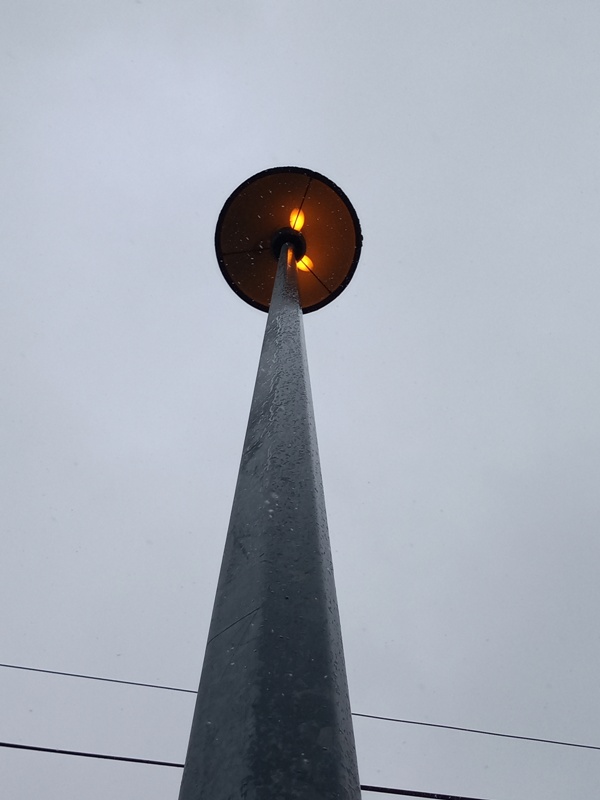The galvanised column shows no signs of corrosion or even surface rust, making dating the installation difficult.
All three lamps appear intact within the lantern.
This is the 'smaller' of the two sizes of Gamma 4 that were produced; 'smaller' meaning a diameter of 914 mm (3 ft) in this case!
The one advantage of the missing bowl is that the lantern's internal construction is revealed, with three struts providing rigidity to the lantern.
Under normal circumstances, the outer core of the lantern's base casting unscrews, and slides a short distance down the column shaft until being stopped by three pegs inserted into the column. In loosening this section, the bowl lowers too, allowing access for maintenance.
Opening the inspection door revealed the individual control gear circuits for the three lamps. The column's backboard had fallen, obscuring the third lamp's ballast, ignitor and capacitor from view.
The ballasts all carried Thorn EMI branding, suggesting that they were manufactured in the mid-1980s.
Just up the lane from this installation, on a footpath to a playground, are several 5 m sheet steel columns of a similar age that support Thorn Gamma 6 Traditional post-top lanterns. The first of these is also derelict, with both the bowl and canopy missing from the lantern.
The column is bent quite significantly above ground level, and the inspection door is missing from the base, revealing a very rusty Metalclad-type fused-spur.
Happily, two further columns further along their footpath were in better condition, with the lanterns being intact on both. Their operational status is unknown, however.
Again, these installations appear deceptively new, with only a slight covering of moss growth on the lantern bowls suggesting that they have been there for some time.
In August 2020, a return visit was paid, with a plan to return the lanterns to lighting (albeit, temporarily) using simulated mains voltage produced from an inverter being powered by a 12 volt car battery, owing to the supply cable long having lost its feed source.
Before continuing, I must stress that you should not attempt to try this yourself; this was done for test purposes only.
The column pictured above, but this time, with the fused isolator bypassed and the simulated mains voltage being connected directly to the lantern's supply cable...the question is, would this Heath-Robinson setup work, especially when the lantern has been out of use for many years?
Yes, it jolly well would! The lantern emitted the characteristic peach glow of a high pressure sodium lamp after only a few minutes of warming up.
Having had an adrenaline rush at the success, the question was raised over whether the next lantern along could be resurrected in the same way, especially as the bowl showed signs of being damaged by airgun pellets. Again, the lamp struck up without too much effort.
An attempt to do anything with the damaged Gamma 6 wasn't made; however, there was one final lantern that was begging to be brought back into operation...the Gamma 4! Thus, despite the heavy rain that was now falling, the fallen backboard was lifted out from where it had fallen in the base, in order to reach the fused isolator once again, and noticed something odd - there were only two gear sets, and possibly, given the limited space on the backboard, there had never been a third...meaning that one of the lamps may never have been lit, even when the supply was still connected! Trying to convince the two connected lamps to work required a bit more work than with the Gamma 6s, owing to corrosion having set in on the connections, with them being located in the damp column base. The capacitors had to be disconnected completely, as they started crackling and oozing some of their internal chemicals, but with a bit of wire waggling, one lamp struggled into life, followed by the other after more coaxing!

The only annoyance was not being able to run the third lamp, but I was amazed that this much was able to be activated!